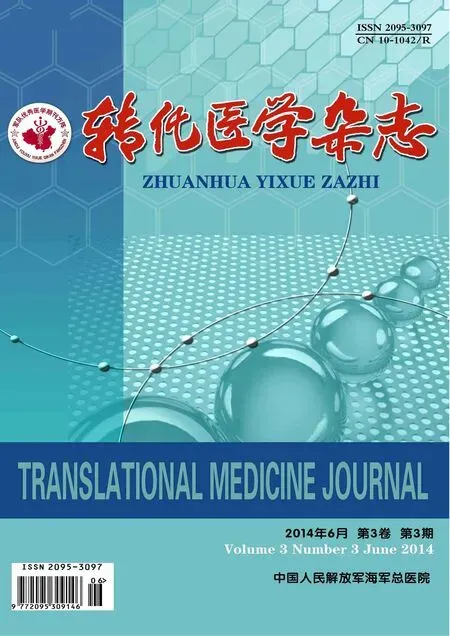液基细胞制片免疫组化染色在胸腹腔积液诊断中的应用
2014-02-16谭永兴江卫民李艳梅屠云娇
谭永兴,江卫民,李艳梅,屠云娇
液基细胞制片免疫组化染色在胸腹腔积液诊断中的应用
谭永兴,江卫民,李艳梅,屠云娇
目的探讨免疫组化技术在细胞学上的应用价值。方法苏木素和伊红染色发现可疑恶性瘤细胞样本104例,样本保存液用液基细胞学沉降式制片进行葡萄糖转运蛋白、钙结合蛋白、细胞表面糖蛋白、上皮抗原免疫组化染色。结果104例可疑肿瘤胸腹腔积液通过免疫标记后均可明确区分癌、间皮瘤或反应性间皮细胞增生。结论性质不明的胸腹腔积液通过细胞免疫组化染色,葡萄糖转运蛋白、钙结合蛋白、细胞表面糖蛋白、上皮抗原联合应用可明确区分积液性质。
胸腔积液;腹腔积液;细胞学;薄层液基涂片;染色
免疫组化在病理组织学诊断中应用广泛,该技术随之运用于液基细胞学沉降式制片。总结我科2012年胸腹腔积液液基细胞学沉降式制片进行免疫组化染色分析的结果,探讨免疫组化技术在细胞学上的应用价值。
1 资料与方法
1.1 资料 细胞学检查胸腹腔积液,苏木素和伊红染色发现恶性或不能排除恶性的细胞样本104例。
1.2 方法
1.2.1 涂片制备及免疫组化染色 样本保存液液基细胞学沉降式制片。样本保存液用95%乙醇固定10~15 min,行钙结合蛋白(Calretinin,CR)、葡萄糖转运蛋白-1(glucose transporter-1,Glut-1)、细胞表面糖蛋白MOC31、上皮抗原(epithelial antigen,EA)免疫组化染色(均为迈新试剂)。
1.2.2 结果判定 以细胞特定部位均匀着棕黄色或棕褐色、细胞数>10%为阳性。
2 结果
104 例疑上皮性肿瘤胸腹腔积液免疫组化CR、Glut-1、MOC31、EA阳性表达结果及对腺癌、恶性间皮瘤、反应性间皮细胞增生的敏感性、特异性见图1~4和表1。

图1 反应性增生的间皮细胞CR标记细胞浆阳性

图2 恶性间皮瘤细胞Glut-1标记细胞膜阳性

图3 腺癌细胞MOC31标记细胞浆/胞膜阳性

图4 散在腺癌细胞EA标记细胞浆阳性

表1 104例CR、Glut-1、MOC31、EA阳性表达及其敏感性和特异性
3 讨论
胸腹腔积液细胞病理学诊断传统的敏感性仅为50%~78%[1],在形态上区分浆膜腔积液中转移性癌细胞和间皮细胞往往是具有挑战性的,困难在于转移性癌细胞与反应性间皮细胞学形态特征有交叉和重叠[2-6]。直接涂片存在大量蛋白液、血液和细胞碎片,常会出现高背景着色,蛋白质聚集在细胞周围阻止免疫试剂进入细胞[4-6];加之产生的三维结构细胞团免疫试剂被包裹其中,导致假阳性反应[6-7]。液基涂片制作中样本保存液可以溶解血和黏液,减少背景着色[8],较原来直接离心涂片具有细胞丰富、分布均匀、薄而不互相折叠、一个样本或同时制得多张涂片进行多种免疫组化染色检测细胞的优点,亚细胞水平抗原分子是其他生物技术难以达到和替代的。查阅相关文献分析后,免疫组化染色我们选择敏感性和特异性不同的抗体是因为:①CR主要用于间皮源性肿瘤的诊断与鉴别诊断,在腺癌细胞不表达或极少数腺癌病例显示灶性胞质弱阳性表达[9-10],主要是低分化结肠癌有表达[9-11],对恶性间皮瘤和间皮细胞增生的敏感性分别是88%~100%和92%~100%[11-14]。本组CR对间皮瘤和间皮细胞增生的敏感性是80%和97%,特异性均是96.6%。②Glut-1用于良恶性肿瘤的鉴别研究很多。如Kato等[15]研究40例反应性间皮细胞增生与48例恶性间皮瘤,发现恶性间皮瘤100%表达Glut-1,而反应性间皮细胞增生均不表达Glut-1。本文病例较少但对恶性间皮瘤的敏感性和特异性均是100%,与报道相似。我们通过CR与Glut-1抗体的联合运用,不仅鉴别了间皮源细胞的良、恶性质,并且选择性地降低了恶性肿瘤(特别是腺癌)细胞的假阳性,提高了恶性肿瘤的诊断准确率。③MOC31主用于腺上皮性肿瘤的诊断及与恶性间皮瘤的鉴别诊断,浆膜腔积液研究报道对腺癌的敏感性76%~100%、特异性92%~100%[16-17],在间皮源性细胞很少有反应[18-19],对乳腺癌的敏感性差异较大为47%~100%[16]。本组MOC31对腺癌细胞的敏感性和特异性分别是94.8%和97.8%,与文献近似,不表达或很少表达间皮源性细胞。④EA是上皮细胞的特异性抗体。Queiroz等[19-20]研究EA在腺癌细胞的表达分别为66.6%和100%,是腺癌细胞的特异性抗体。本组EA对腺癌细胞的敏感性和特异性都在93%以上,但在恶性间皮瘤或反应性间皮细胞增生中有很少量表达。因此,选择EA作为MOC31的补充,双重互补以达到诊断更加准确。通过本组疑癌或有癌胸腹腔积液液基细胞学沉降式制片免疫组化染色,CR、Glut-1、MOC31、EA抗体组合应用[21],双重互补,正反两面证实,能弥补光学显微镜下诊断的局限性;对性质不明的胸腹腔积液免疫组化染色可起到鉴别诊断的作用,具有很大的临床应用价值。
[1]Queiroz C,Barral-Netto M,Bacchi CE.Characterizing subopulations of neoplastic cells in serous effusions.The role of immunocytochemistry[J].Acta Cytol,2001,45(1):18-22.
[2]Festch PA,Abati A.Immunocytochemistry in effusion cytology:a contemporary review[J].Cancer,2001,93(5):293-308.
[3]Lozano MD,Panizo A,Toledo GR,et al.Immunocytochemistry in the differential diagnosis of serous effusions:a comparative evaluation of eight monoclonal antibodies in Papanicolaou stained smears[J].Cancer,2001,93(1):68-72.
[4]Dejmek A,Hjerpe A.Reactivity of six antibodies in effusions ofmesothelioma,adenocarcinoma and mesotheliosis:stepwise logistic regression analysis[J].Cytopathology,2000,11(1):8-17.
[5]Delahaye M,van der Harn F,van der kwast TH.Complementary value of five carcinomamarkers for the diagnosis of malignant me-sothelioma,adenocarcinoma metastasis,and reactive mesothelium in serous effusions[J].Diagn Cytopathol,1997,17(2):115-120.
[6]Chowdhuri SR,Fetsch P,Squires J,et al.Adenocarcinoma cells in effusion cytology as a diagnostic pitfallwith potential impact on clinical management:a case report with brief review of immunomarkers[J].Diagn Cytopathol,2014,42(3):253-258.
[7]Fetsch PA,Simsir A,Brosky K,et al.Comparison of three commonly used cytologic preparations in effusion immunocytochemistry[J].Diagn Cytopathol,2002,26(1):61-66.
[8]Dabbs DJ,Abendroth CS,Grenko RT,et al.Immunocytochemistry on the Thinprep®processor[J].Diagn Cytopathol,2006,17(5):388-392.
[9]Cury PM,Butcher DN,Fisher C,et al.Value of themesothelium-associated antibodies thrombomodulin,cytokeratin 5/6,calretinin,and CD44H in distinguishing epithelioid pleural mesothelioma from adenocarcinoma metastatic to the pleura[J].Mod Pathol,2000,13(2):107-112.
[10]Stewart DJ.Tumor and host factors thatmay limit efficacy of chemotherapy in non-small cell and small cell lung cancer[J].Crit Rev Oncol Hematol,2010,75(3):173-234.
[11]Wieczorek TJ,Krane JF.Diagnostic utility of calretinin immunohistochemistry in cytologic cell block preparations[J].Cancer,2000,90(5):312-319.
[12]Nagel H,Hemmerlein B,Ruschenburg I,et al.The value of anti-calretinin antibody in the differe-ntial diagnosis of normal and reactive mesothelia versus metastatic tumors in effusion cytology[J].Pathol Res Pract,1998,194(11):759-764.
[13]Kitazume H,Kitamura K,Mukai K,et al.Cytologic differential diagnosis among reactivemesothelial cells,malignant mesothelioma,and adenocarcinoma:utility of combined E-cadherin and calretinin immunostaining[J].Cancer,2000,90(1):55-60.
[14]Chhieng DC,Yee H,Schaefer D,et al.Calretinin staining pattern aids in the differentiation of mesothelioma from adenocarcinoma in serous effusions[J].Cancer,2000,90(3):194-200.
[15]Kato Y,Tsuta K,Seki K,et al.Immunohistochemical detection of GLUT-1 can discriminate between reactive mesothelium and malignant mesothelioma[J].Mod Pathol,2007,20(2):215-220.
[16]Kuenen-Boumeester V,van Loenen P,de Bruijn EM,etal. Quality control of immunocytochemical staining of effusions using a standardized method of cell processing[J]. Acta Cytol,1996,40(3):475-481.
[17]Ordóñez NG.Role of immunohistochemistry in differentiating epithelialmesothelioma from ademocarcinoma[J].Am JClin Pathol,1999,112(1):75-89.
[18]Ordóñez NG.Role of immunohistochemistry in distinguishing epithelial peritoneal mesotheliomas from peritoneal and ovarian serous carcinomas[J].Am J Surg Pathol,1998,22(10):1203-1214.
[19]Queiroz C,Barral-Netto M,Bacchi CE.Characterizing subpopulations of neoplastic cells in serous effusions.The role of immunocytochemistry[J].Acta Cytol,2001,45(1):18-22.
[20]Carella R,Deleonardi G,D′Errico A,et al.Immunohistochemical panels for differentiating epithelial malignant mesothelioma from lung adenocarcinoma:a study with logistic regression analysis[J].Am JSurg Pathol,2001,25(1):43-50.
[21]Morgan RL,De Young BR,McGaughy VR,et al.MOC-31 aids in the differentiation between adenocarcinoma and reactivemesothelial cells[J].Cancer,1999,87(6):390-394.
Application of liquid based cell production of immunohistochem ical staining in the diagnosis of pleural effusion and ascites
TAN Yongxing,JIANGWeimin,LIYanmei,TU Yunjiao
(Department of Pathology,The First People′s Hospital of Honghe Prefecture,Mengzi Yunnan 661199,China)
ObjectiveTo study the liquid based cytology production technology application of immunohistochemical staining.MethodsHematoxylin and eosin staining smear samples of suspiciousmalignant tumor cells remaining preservation solution made more than LBP system and then smear for immunohistochemical stain glucose transporter-1(Glut-1),calretinin(CR),cell surface glycoprotein MOC31,epithelial antigen(EA).ResultsOne hundred and four cases of suspicious tumor after chest water by immune markers clearly distinguished as carcinoma or mesothelioma or reactive mesothelium cell hyperplasia.ConclusionThe immunohistochemical antigen-antibody reaction is high specificity and sensitivity of biochemical reactionswith specific antigen recognition. Antigen molecules in the cellular and subcellular level testing is difficult to achieve and replace,which has a broad application in cytology.Unidentified pleural effusion by cell immunohistochemical staining,combined application of CR,Glut-1,MOC31,and EA properties can clearly distinguish effusion.
Pleural effussion;Seroperitoneum;Cytology;Thinlayerliquidbasedsmears;Staining
R392.31;R442.5
B
2095-3097(2014)03-0147-03
10.3969/j.issn.2095-3097.2014.03.006
2014-03-27 本文编辑:冯 博)
661199云南蒙自,红河州第一人民医院病理科(谭永兴,江卫民,李艳梅,屠云娇)
